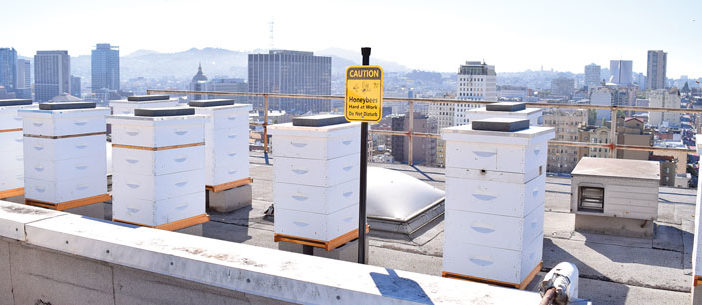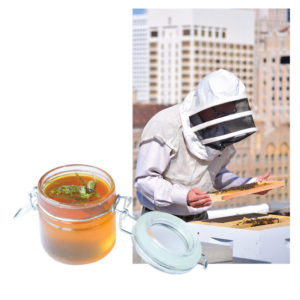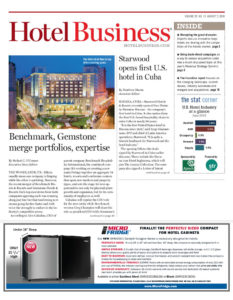SAN FRANCISCO—There’s an ingredient that’s creating a real buzz, piquing guest interest and making its way onto the menu. The color of gold, it tastes as sweet as candy. The ancient Greeks called it “the nectar of the Gods.” Today, we call it honey.
The Clift hotel, part of Morgans Hotel Group, is now offering a menu of dishes and drinks that feature the divine additive sourced through the 10 honeybee hives on the hotel’s rooftop.
“Guests are curious about the bees and honey,” said Michael Pace, GM of Clift, located here. “The most common question I’m asked is, ‘Can I see the hives?’ So I bring them to the top of the roof so they can visit.”
In addition to Clift, nearly 10 other hotels in San Francisco have honeybee hives as part of the city’s urban bee and herb garden program, including Fairmont, W Hotel, Hotel Zetta, Marriott Fisherman’s Wharf and Holiday Inn and Express Fisherman’s Wharf.
Roger Garrison, a local beekeeper, was hired to install the beehives and now maintains and cares for the bees. Garrison positioned the hives to mimic the San Francisco city grid below. He incorporated miniature skyscrapers and the gold dome of city hall, which is now peeking out from behind the hives. “It’s a turnkey project. We pay him a monthly fee,” Pace offered, adding that it was Garrison’s passion for beekeeping that set him apart from other applicants for the job.
Garrison purchased and selected the 10,000 bees and one queen that Clift began with in May 2015, checking them for health, aggression and alertness. The hotel now has about 300,000 bees with an average of 30,000 in each hive. All are from California because it was crucial that the bees were local, according to Pace. “In a very healthy hive there can be 70,000 to 80,000 bees. We are about halfway there now,” Pace said.
Pace and Garrison explained that San Francisco and other major cities across the world have successful urban beekeeping programs. Bees use the city’s public parks as their landing and pollination zones. “You think bees can’t survive in the city but that’s not correct,” Garrison explained in a video dedicated to Clift’s beekeeping program. “There’s plenty of foraging opportunities for them with the trees and flowers.”
The hotel is slated to harvest its second batch of honey after a successful first batch. “He’s always careful to take no more than 40% of the honey so there is enough for the bees,” Pace said of Garrison.
In the last batch, Garrison harvested five gallons of honey. Some of it was used to create Clift’s recent menu additions, including a selection of four items that were made with honey that was produced in the San Francisco area. The menu was created by Clift’s Executive Chef Thomas Weibull and includes honey-glazed, adobo-style baby back ribs and watermelon salad with a honey and lavender infusion. The hotel also has two mixed drinks featuring the sweetener: The Peerless Purple, which is gin infused with local honey and lavender and 49er Tea Time, which is black tea whiskey with an infusion of honey and citrus.
“A nice benefit to us is we get this great honey to serve our guests,” Pace said of fostering the urban bee and herb garden program with the rooftop hives. According to Pace, the hotel’s motivations for starting the program were more about sustainability and environmentalism than anything else because honeybees and their colonies have been suffering from colony collapse disorder (CCD). This phenomenon happens when the majority of worker bees in a colony disappear, leaving behind food and valuable nurse bees to protect and nurture their young. In an astonishing move, the worker bees will also leave behind their queen. Disappearances like this have been around since the start of beekeeping under different names, including “disappearing disease” and “spring dwindle.” North America and Europe noted a decline in the honeybee population beginning in 2006.
According to Pace, scientists have not figured out why CCD is occurring or how to stop it from happening. Work is being done at universities across the world to get a handle on it, exploring such theories as pollution, pesticides and tainted water.
“I thought, let’s do something not about the individual hotel but about a group of hotels. Now we’re doing something good for the community and environment,” said Pace, who has been a GM in San Francisco for 18 years with nearly two spent at the Clift hotel.
Joining the honeybee program is easy, according to Pace. First, the hotels need to join the hotel council of San Francisco and they need to have a sustainability program in place at their hotel. Plus, they have to genuinely want to be part of a sustainability program. “I believe as hoteliers that we can do more to reduce our carbon footprint. When we add this element of a story of helping the environment it sends the right message to guests that hoteliers are good people,” Pace said. HB



